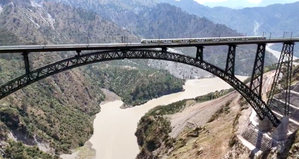Jammu: The Sangaldan-Reasi rail link in Jammu and Kashmir is expected to be flagged off by the end of June, officials said on Saturday.
Officials said that the final inspection of the Sangaldan-Reasi section of USBRL, including the world’s highest railway bridge over the Chenab River, will be conducted later this month.
“Regular train service will start by the end of this month or in the first week of July from Baramulla to Reasi. Only a 17 km long section from Reasi to Katra remains to be made operational, which will be done within six months,” an official said.
A trial run of the MEMU train (Mainline Electric Multiple Unit) was conducted recently on the newly-constructed electrified line section (Reasi-Sangaldan), covering a route length of 46 km on the Udhampur-Srinagar-Baramula Rail Link (USBRL) project, at a speed of 40 kmph.
This was the first time that a full train crossed over the Chenab River bridge between Dugga and Bakkal stations. This bridge is the world’s highest railway bridge featuring a central span of 467 metres at an impressive height of 359 metres, which is higher than the Eiffel Tower in Paris.
So far, 209 km out of the total 272 km of USBRL already stands commissioned. The phases include the 118 km Qazigund-Baramulla section commissioned in October 2009, the 18 km Banihal-Qazigund section commissioned in June 2013, the 25 km Udhampur-Katra section commissioned in July 2014, and the 48.1 km Banihal-Sangaldan stretch commissioned in February this year.
Once the Reasi-Katra section becomes operational, the Kashmir Valley will be connected by the rail link with the rest of the country.
Work on the project began in 1997 and it passes through some of the most difficult topography in the history of rail link laying projects in the world.
Once the USBRL becomes operational, it would not only be the realisation of the centuries-old dream of a rail link between the landlocked Valley and the rest of the country, but also an iconic marvel of engineering for which thousands of engineers, skilled and semi-skilled workforce spent decades.
–IANS


Comments are closed.